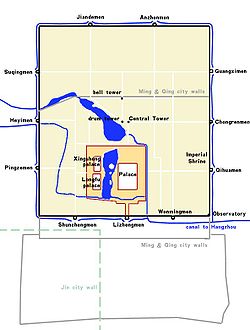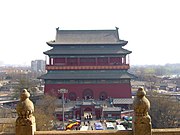
Back Khanbaliq ALS Xanbalıq Azerbaijani Cambaluc Catalan Hanbalıq CRH Cambaluc German Ĥanbaliko Esperanto Janbalic Spanish خان بالق Persian Cambaluc French חאנבאליק HE
| Khanbaliq (Dadu of Yuan) | |
|---|---|
| Native names Chinese: 汗八里 Wade-Giles: Han-pa-li Mongolian: Ханбалиг ᠬᠠᠭᠠᠨ ᠪᠠᠯᠭᠠᠰᠤ Qaɣan balɣasu | |
| (元)大都 (Yüan) Ta-tu ᠳᠠᠶ᠋ᠢᠳᠤ | |
 | |
| Type | Former capital city |
| Location | Beijing, China |
| Coordinates | 39°56′0″N 116°24′0″E / 39.93333°N 116.40000°E |
| Founded | 1264 |
| Founder | Kublai Khan |
| Khanbaliq | |||||||||
|---|---|---|---|---|---|---|---|---|---|
 | |||||||||
| Chinese name | |||||||||
| Chinese | 汗八里 | ||||||||
| |||||||||
| Mongolian name | |||||||||
| Mongolian Cyrillic | Хаан балгас, Ханбалиг | ||||||||
| Mongolian script | ᠬᠠᠭᠠᠨ ᠪᠠᠯᠭᠠᠰᠤ | ||||||||
| |||||||||
| Dadu | |||||||||
|---|---|---|---|---|---|---|---|---|---|
| Chinese name | |||||||||
| Chinese | (元)大都 | ||||||||
| Literal meaning | Grand Capital (of Yuan) | ||||||||
| |||||||||
| Mongolian name | |||||||||
| Mongolian script | ᠳᠠᠶ᠋ᠢᠳᠤ | ||||||||
| |||||||||
| Beiping | |||||||||
|---|---|---|---|---|---|---|---|---|---|
| Chinese | 北平 | ||||||||
| Literal meaning | [Seat of the] Northern Pacified [Area] | ||||||||
| |||||||||

Khanbaliq (Chinese: 汗八里; pinyin: Hànbālǐ; Mongolian: ᠬᠠᠭᠠᠨ ᠪᠠᠯᠭᠠᠰᠤ, Qaɣan balɣasu) or Dadu of Yuan (Chinese: 元大都; pinyin: Yuán Dàdū; Mongolian: ᠳᠠᠶ᠋ᠢᠳᠤ, Dayidu) was the winter capital[1] of the Yuan dynasty of China in what is now Beijing, the capital of China today. It was located at the center of modern Beijing. The Secretariat directly administered the Central Region (腹裏) of the Yuan dynasty (comprising present-day Beijing, Hebei, Shandong, Shanxi, and parts of Henan and Inner Mongolia) and dictated policies for the other provinces. As emperors of the Yuan dynasty, Kublai Khan and his successors also claimed supremacy over the entire Mongol Empire following the death of Möngke (Kublai's brother and predecessor) in 1259. Over time the unified empire gradually fragmented into a number of khanates.
Khanbaliq is the direct predecessor to modern Beijing. Several stations of Line 10 and Line 13 are named after the gates of Dadu.
- ^ Masuya Tomoko, "Seasonal capitals with permanent buildings in the Mongol empire", in Durand-Guédy, David (ed.), Turko-Mongol Rulers, Cities and City Life, Leiden, Brill, p. 236.
© MMXXIII Rich X Search. We shall prevail. All rights reserved. Rich X Search